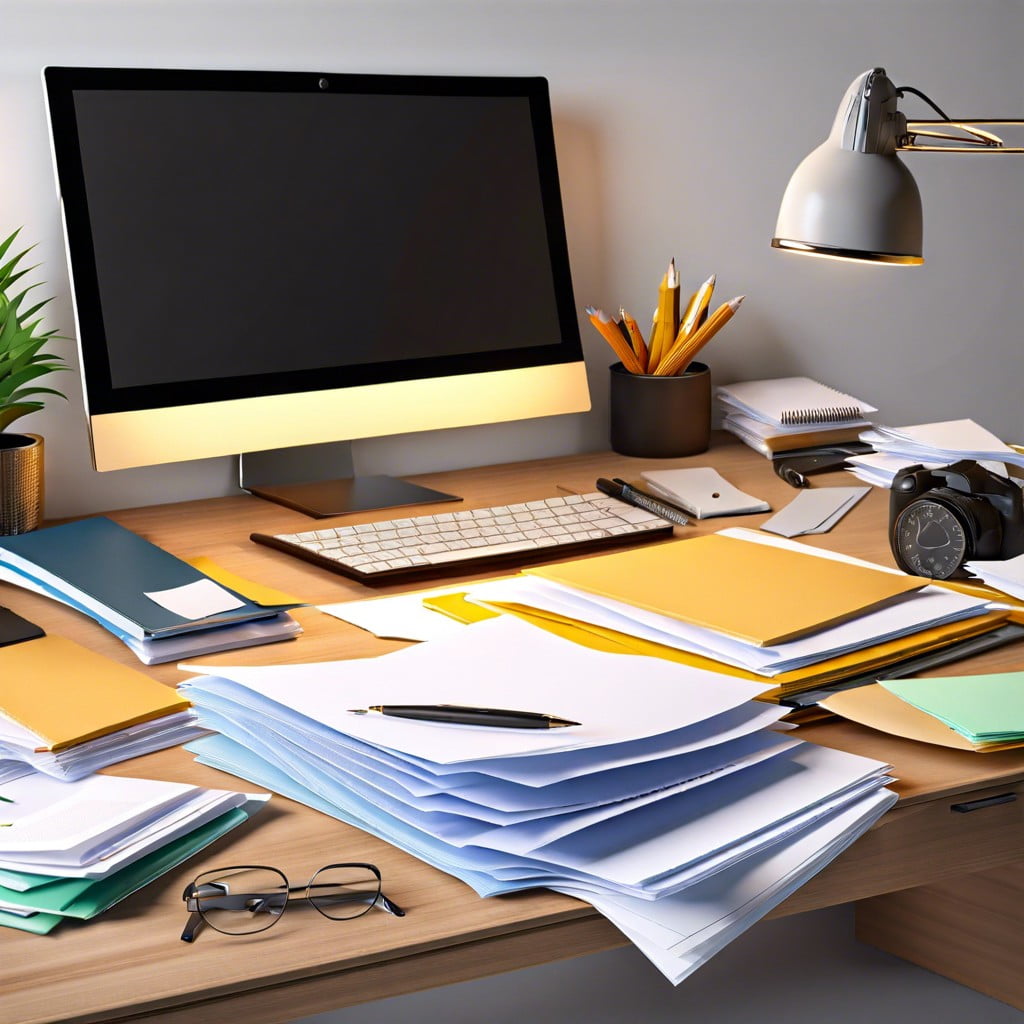Learn practical steps to efficiently declutter your mountain of paperwork and regain control of your space.
Key takeaways:
- Assess the magnitude of your paper clutter
- Divide papers into two piles: discard or keep
- Shred sensitive documents, recycle unnecessary papers
- Archive important documents digitally or in labeled folders
- Opt for electronic statements and bills, unsubscribe from unnecessary mail
Assess the Magnitude of Your Paper Clutter

Start by evaluating each room that contains paperwork. Look at desks, drawers, shelves, and even those “miscellaneous” stacks that seem to grow on their own. Don’t be shy; dive right into the piles—it’s the first step to reclaim your space!
Note where the bulk of your papers tend to accumulate. Is it near the entrance, on the kitchen counter, or perhaps hiding away in a home office? Recognizing these hotspots helps pinpoint the main sources of your paper accumulation.
Quickly skim through the papers to identify what types of documents you have. You might find bills, receipts, old notes, or even forgotten birthday cards. This initial scan will give you a rough idea of what you’re dealing with and how much time you might need to set aside for the sorting phase.
Remember, this isn’t about organizing yet—it’s about seeing the big picture of your paper chaos. Think of it like mapping the terrain before you start the hike.
Steps for Decluttering Paperwork
First, tackle the paper jungle by dividing everything into two simple piles: one for papers to keep, and another for those to say goodbye to. Remember, when in doubt, throw it out (or better yet, recycle it!).
Next, safeguard your identity while decluttering. Shred any documents with personal information that you no longer need. This includes old bills, bank statements, and expired IDs. Keep your shredder busy and your mind at ease.
For those papers you just can’t part with, digital archiving can be a game changer. Use a scanner or your smartphone to create digital copies. Label and organize them in electronic folders. Physical copies can go into clearly marked folders, ideally stored in a fireproof safe.
Finally, cut down on future clutter. Opt-in for electronic statements and bills where possible, and unsubscribe from unnecessary mail. Set a reminder for a quick monthly paperwork sweep. This ensures your pile doesn’t turn into a mountain again.
Step 1: Sort Papers Into Two Piles: Discard or Keep
Sorting is the linchpin of decluttering your paper mountain. Face this task armed with a clear mindset: if it’s not necessary, it’s confetti waiting to happen.
Start by creating two distinct zones. One for “keep” — this pile is for items that scream importance or future need. Think legal documents, insurance policies, or recent tax returns. The other pile, “discard,” should be for outdated bills, old magazines, and the third copy of that take-out menu from your favorite pizza place.
While sorting, ask yourself: “Have I used this in the last year?” If the answer is no and it’s not a required document, into the discard pile it goes. This straightforward question can help slash through paperwork like a warm knife through butter!
Remember, this step isn’t about organizing; it’s about categorizing. Resist the urge to file anything away neatly just yet. That comes later. Now, it’s all about broad strokes and decisive actions. Keep it swift, and keep it simple.
Step 2: Shred Sensitive Documents and Recycle Unnecessary Papers
Consider the fun of pretending to be a secret agent while shredding your documents—privacy protected, mission accomplished! Shredding isn’t just for spies; it’s essential for anyone wanting to protect their sensitive information. Look out for anything that holds your social security number, bank account details, or personal information. Snip them through the shredder!
Recycling papers may not feel as thrilling, but imagine you’re saving a tree with every batch—you kind of are! Old magazines, newspapers, and non-confidential documents don’t need to take up space in your drawers. Remember to check if the paper is recyclable first—you don’t want to be the person who wishes to save the trees but accidentally jams up the recycling plant.
Both of these actions will sweep the clutter from your life one satisfying shred and recycle bin at a time. Keep that shredder handy and the recycling bin open, and watch the mountains of unnecessary paperwork dwindle. Just think of it as a magic trick where you’re making messes disappear!
Step 3: Archive Important and Less Frequently Used Papers Digitally or in Labeled Folders
Embracing digital solutions can revolutionize your paper management prowess. Scanning important documents not only saves space but also offers easier retrieval when needed. Use cloud-storage services or external hard drives for backup, ensuring your data remains secure and accessible.
For papers that you need to retain physically, organizing them into labeled folders will be a lifesaver. This method keeps them tidy and systematic. Consider using categories like ‘Tax Documents’, ‘Home Maintenance’, ‘Personal IDs’, etc. Transparent sleeves can protect these documents from damage while allowing you to quickly see what’s inside without needing a full-fledged archaeological dig every time you need your passport or home insurance papers.
Regular updates to both your digital archives and physical folders will keep them from reverting to chaos. Schedule a bi-annual review to discard outdated documents and incorporate new ones. This ongoing process supports a sustained organization that makes handling paperwork almost a breeze—almost.
Related Stories
- Paper Clutter: How to Reduce and Organize Effectively
- Paperwork Decluttering: Tips for Organizing and Maintaining Important Documents
- How to Get Rid of Stuff: Simple Steps for a Clutter-Free Home
- Things to Declutter: Simple Tips to Simplify Your Space
- Decluttering Tips: 10 Easy Steps to Transform Your Space